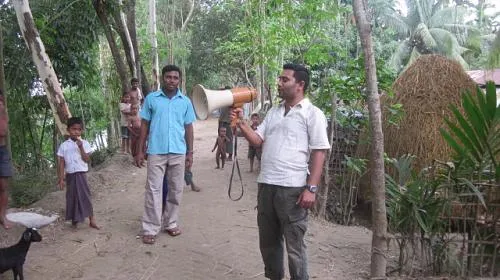UPDATE: Cyclone Mahasen hit Bangladesh’s southern coast on Thursday morning, while heavy rains and strong winds lashed neighboring Myanmar. Initial reports indicate approximately 4.1 million people are affected in Bangladesh alone, and entire towns in low-lying areas are under four feet of water. CARE has begun carrying out our emergency response and will know more about the scope of the disaster in the coming hours and days.
DHAKA/YANGON (May 15, 2013) – As Tropical Cyclone Mahasen moves across the Bay of Bengal towards Bangladesh and Myanmar, the humanitarian organization CARE is preparing to provide emergency assistance to affected communities in both countries. The storm is expected to deliver heavy rain and damaging winds when it makes its projected landfall Thursday evening or Friday morning near the border of Bangladesh and Myanmar.
“We have 247 trained and experienced emergency responders ready in the areas which are likely to bear the brunt of the cyclone,” said Alex Maclean, CARE’s assistant country director in Bangladesh. “A larger team is on stand-by for a broader response if the cyclone affects vulnerable people elsewhere in the coastal belt.”
In Bangladesh, CARE is preparing to provide relief in Chittagong, Cox’s Bazar and Noakhali, the three districts projected to be in the path of the storm. CARE has emergency family kits for 20,000 families and food rations for 6,000 families ready for distribution. Emergency family kits include plastic sheeting for shelter, water containers, water purification tablets, soap, cooking pots and utensils. CARE also has readied six mobile water treatment plants and supplies of water purification sachets to help prevent the spread of disease. CARE’s teams in both countries are trained to recognize the particular needs of girls and women in emergencies and have planned to ensure gender equity is built-in to any emergency response.
In Myanmar, CARE is ready to distribute emergency family kits and clothing for 20,000 families. CARE is also sending water pumps and other equipment to Rakhine State to assist with pumping out water ponds and clearing debris if required. Situated on Myanmar’s western coast, Rakhine State is home to nearly 140,000 people displaced by ongoing civil unrest that began in June 2012.
“We are particularly concerned about the risks facing displaced people living in flood-prone areas and in flimsy, make-shift shelters. Thousands of people live near the coast, putting them at-risk of tidal surges, while others are camped in low-lying areas that will flood once the rains start,” said Brian Agland, CARE’s country director in Myanmar. “For people living in tents or tarpaulin shelters, flood waters can quickly wash away their possessions, leaving them homeless, empty-handed and hungry. Flooding can also increase the risk of waterborne diseases, such as cholera and diarrhea.”
CARE’s emergency response teams in Bangladesh and Myanmar are coordinating with government authorities in Myanmar and Bangladesh, with other humanitarian aid organizations and the United Nations.
About CARE:
Founded in 1945 with the creation of the CARE Package, CARE is a leading humanitarian organization fighting global poverty. CARE has more than six decades of experience delivering emergency aid during times of crisis. Our emergency responses focus on the needs of the most vulnerable populations, particularly girls and women. Women and girls are at the heart of CARE’s emergency relief efforts because our experience shows that their gains translate into benefits for families and communities.
CARE has been working in Bangladesh since 1949 and has extensive experience responding to emergencies in both countries. In 2007, CARE responded to Cyclone Sidr, reaching nearly 500,000 people with food, water, sanitation and shelter. CARE has worked in Myanmar since 1995. After 2008’s devastating Cyclone Nargis, CARE Myanmar reached nearly 300,000 survivors with food, shelter, emergency supplies and assistance with recovery.
Essential to CARE’s lifesaving humanitarian work is our commitment to help rebuild safer, stronger places that people call home. Our programs to improve health and education, promote social justice and open up economic opportunities make communities more resilient and less vulnerable to the forces that cause emergencies. Last year, CARE worked in 84 countries and reached more than 83 million people around the world. To learn more, visit www.care.org.
Media Contacts:
Atlanta: Brian Feagans, CARE, bfeagans@care.org, +1.404.979.9453, +1.404.457.4644
Atlanta: Nicole Harris, CARE, nharris@care.org, +1.404.979.9503, +1.404.735.0871

